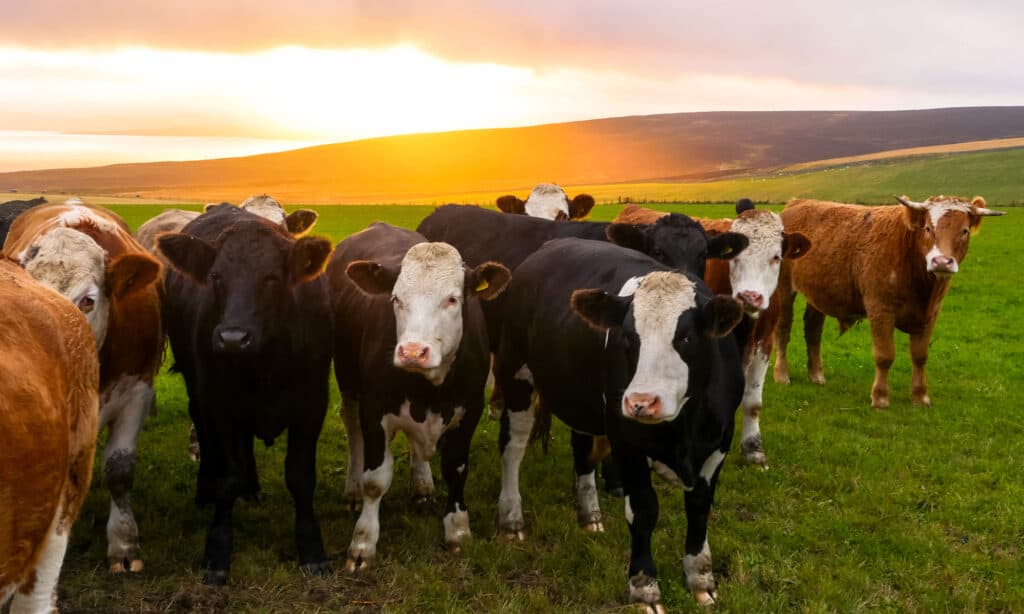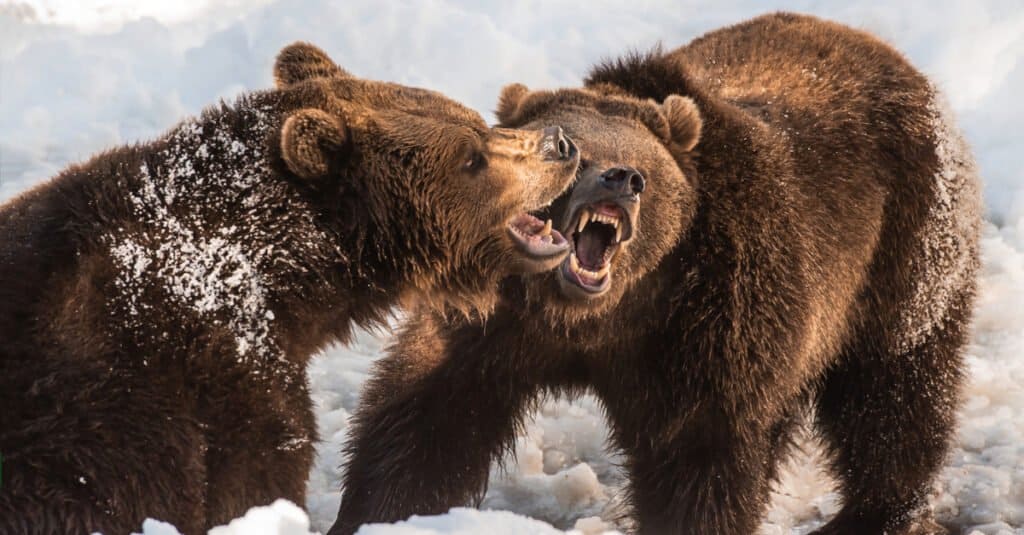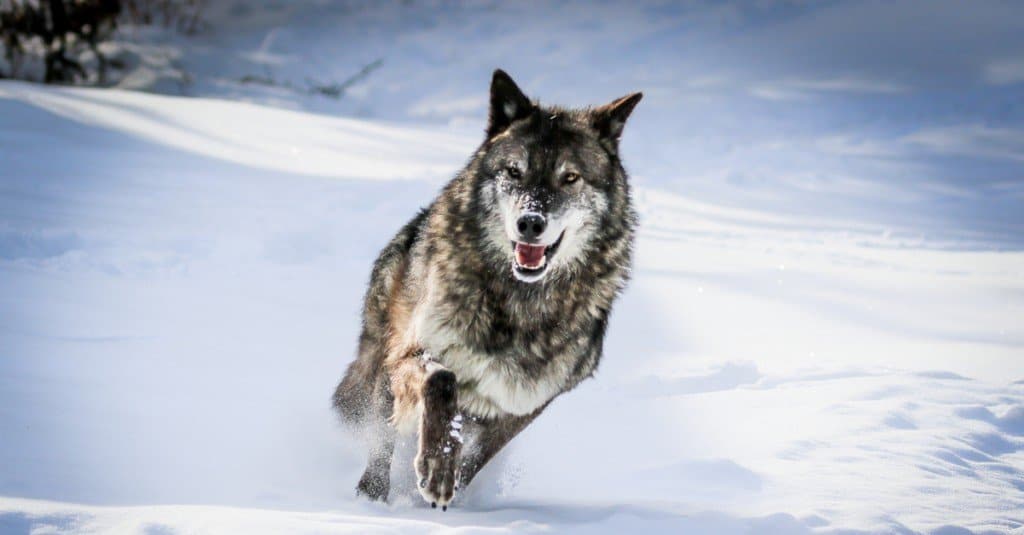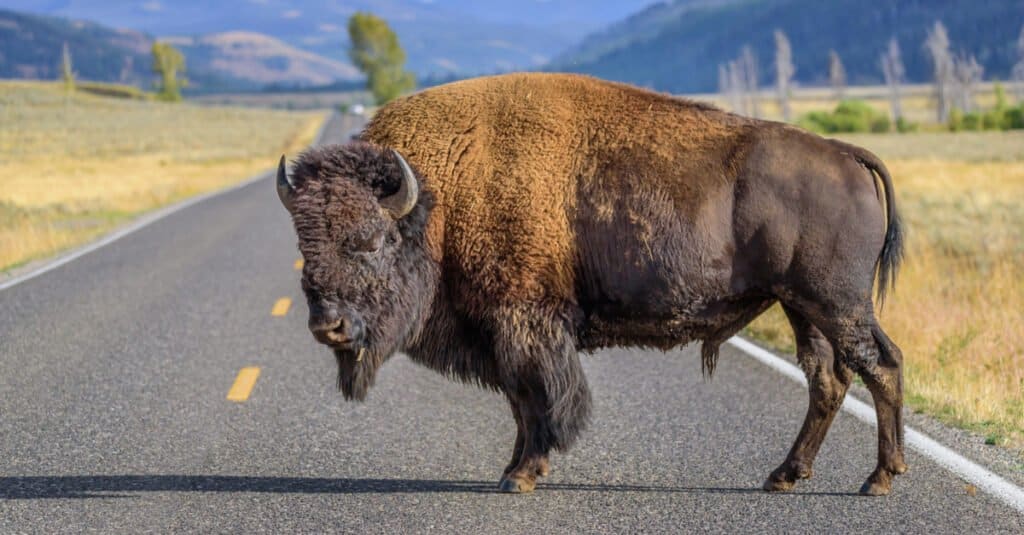What dangerous animals are in Wyoming? Yellowstone National Park is in Wyoming and has herds of bison, grizzly bears, and enormous elk. Those names sound pretty dangerous. Wyoming is also known as the “Cowboy State,” with 12,000 farms and ranches. Herding cattle is dangerous, and so is handling a 1,500lb aggressive bull. Let’s find out about some of the most dangerous animals in Wyoming.
How Are Cattle Dangerous Animals?

Working with cattle in enclosed areas and herding them are the 2 most dangerous conditions with cows.
©M. Vinuesa/Shutterstock.com
Farming is a dangerous profession. Most farming accidents are related to farm machinery, but a fair number of accidents and fatalities occur with animals. Horses and cattle are the most dangerous animals on the farm. According to a study by the Iowa Department of Public Health, there were 108 cattle-related fatalities between 2003-2008 in four farming states (Iowa, Kansas, Missouri, and Nebraska). Although Wyoming was not included in this study, one can assume statistics would be similar in a state like Wyoming. Of those fatalities, 33% happened when working with cattle in an enclosed area, 24% were from moving and herding cattle, 14% were from loading, and 14% were from feeding. To avoid injuries, farm and ranch workers need to be educated about the best practices in handling livestock and be diligent about recognizing signs of aggression. This will help prevent as many accidents as possible.
Are Bears The Most Dangerous Animals In Wyoming?

Grizzly bears are one of the most dangerous animals in Wyoming. 700 are estimated in Yellowstone Park.
©Alexandra Giese/Shutterstock.com
The Yellowstone National Park website warns people to keep a minimum of 100 yards from bears and wolves. The park is home to both grizzly and black bears and a healthy population of gray wolves.
- Grizzly bears: There are around 700 grizzly bears in Yellowstone. This is one of the few locations in the lower 48 states where grizzlies still live. Grizzly bears are larger and more aggressive than black bears. They can weigh between 200-700lbs and are about 3.5 feet tall at the shoulder. Their claws are longer and more curved than those of black bears as well. Bear attacks on humans are very rare. According to Yellowstone officials, there is on average only one bear attack per year. With nearly 3 million visitors a year, the odds are very slim.
- Black bears: Black bears are smaller than grizzly bears, but at 200-400lbs, they are still dangerous animals. Black bears can be a variety of colors including cinnamon and brown, but they differ from grizzlies in that they don’t have the hump at their shoulders like grizzlies. It is best to stay away from all bears regardless if you can tell them apart.
When Was The Last Bear Attack In Wyoming?
On October 2, 2021, a grizzly bear in Cody, Wyoming, attacked a hunter. The man reported being suddenly attacked by what was later identified as a mother bear with two cubs. Bears typically avoid humans, but protecting their cubs is one case where they have been known to be aggressive. The man and his hunting partner were able to shoot the bear and get away, but he received some injuries.
If you are hiking in bear country, always be prepared and carry bear spray. Hunters may not have had time to use bear spray, but in most cases, bear spray is an effective tool to deter bears.
Are Wolves The Most Dangerous Animals In Wyoming?

There are about 75 different wolf packs that live in the Yellowstone area. Each pack has 6-10 wolves.
©Holly S Cannon/Shutterstock.com
- Gray wolves: Gray wolves live in packs of 6-10 and they live in Wyoming. There are approximately 75 different packs of wolves that live in the Yellowstone area. Wolves used to roam throughout the state, and much of the northern United States, but by the late 1920s, almost all of the wolves in the United States had been killed. Yellowstone is now one of the protected areas for the gray wolf. Wolves are about the size of a large dog, averaging 100lbs and standing about 30 inches tall at the shoulder.
Wolf attacks on humans are extremely rare, and according to Yellowstone authorities, “no wolf has attacked a human in Yellowstone.” In 2010, there was a fatal wolf attack in Alaska when a 32-year-old teacher was out jogging. She was attacked by multiple wolves and sustained fatal injuries. However, wolf attacks are extremely rare.
What About Bison And Elk? Are These The Most Dangerous Animals In Wyoming?

The American bison is also known as the American
buffalo
.
©iStock.com/IngerEriksen
- Bison: Yellowstone recommends people keep at least 25 yards from bison and elk. Bison can go from happily grazing to full force charging in seconds and can turn on a dime. People who get too close to take photos put themselves and others at risk. Bison weigh nearly 2,000lbs and have large powerful heads with sharp horns. Between 2000 and 2015, there have been 25 people injured by bison in Yellowstone. In June 2021, a 30-year-old woman was taken to the hospital after an encounter with a bison. She had been hiking near the north end of Yellowstone Lake in Wyoming.
- Elk: Elk are dangerous animals in Wyoming, especially during mating season. A man was caught on tape trying to video an elk in front of a hotel in Mahomet Hot Springs. What he didn’t know was that he stepped between a male and female bull, and the male charged at him. He avoided injury, but was too close for comfort to the bull’s large rack of antlers. A bull elk’s antlers can have seven to eight points each, and reach a width of 3-4 feet. Keeping your distance from these animals is the safest thing to do.
Are There Any Venomous Animals In Wyoming?

The female black widow spider is the only one with venom that is dangerous to humans, not the males.
©Sari ONeal/Shutterstock.com
- Prairie rattlesnake: This is the only venomous snake in Yellowstone. It is a greenish-gray snake with tan markings, is 4-5 feet long, and has the largest range of all the rattlesnakes in the United States.
- Midget-faded rattlesnake: This is a small snake. It is less than 2 feet long, has tan with light brown markings, is found along the Green River in the rocky cliff areas, and its venom is quite toxic but bites on humans is rare.
- Northern scorpion: This is the only native scorpion that can be found in Wyoming. It is much smaller than a southern scorpion, is only about an inch long, and it’s venomous but not very toxic.
- Black widow spider: This is a black spider with a red hourglass marking on its back. It typically has its web out of sight, and only the female is harmful to humans.
All the venomous animals in Wyoming are dangerous, but if you seek immediate medical attention, the chances of a bite being fatal are rare. Medical facilities in the United States carry antivenom and can help ease the effects of bites. Keeping your distance from snakes and being aware of where scorpions or black widows may be can help reduce your chances of being bitten. So, venomous animals in Wyoming are dangerous but rarely fatal.
Summary of the Most Dangerous (Deadliest!) Animals in Wyoming
| Rank | Animal |
|---|---|
| 1 | Cattle |
| 2 | Bears |
| 3 | Wolves |
| 4 | Bison |
| 5 | Elk |
| 6 | Spiders |
| 7 | Rattlesnakes |
| 8 | Scorpions |
The photo featured at the top of this post is © Szczepan Klejbuk/Shutterstock.com
Thank you for reading! Have some feedback for us? Contact the AZ Animals editorial team.






